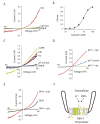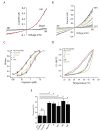TRPV1 channels are intrinsically heat sensitive and negatively regulated by phosphoinositide lipids
- PMID: 23439120
- PMCID: PMC3583019
- DOI: 10.1016/j.neuron.2012.12.016
TRPV1 channels are intrinsically heat sensitive and negatively regulated by phosphoinositide lipids
Abstract
The capsaicin receptor, TRPV1, is regulated by phosphatidylinositol-4,5-bisphosphate (PIP(2)), although the precise nature of this effect (i.e., positive or negative) remains controversial. Here, we reconstitute purified TRPV1 into artificial liposomes, where it is gated robustly by capsaicin, protons, spider toxins, and, notably, heat, demonstrating intrinsic sensitivity of the channel to both chemical and thermal stimuli. TRPV1 is fully functional in the absence of phosphoinositides, arguing against their proposed obligatory role in channel activation. Rather, introduction of various phosphoinositides, including PIP(2), PI4P, and phosphatidylinositol, inhibits TRPV1, supporting a model whereby phosphoinositide turnover contributes to thermal hyperalgesia by disinhibiting the channel. Using an orthogonal chemical strategy, we show that association of the TRPV1 C terminus with the bilayer modulates channel gating, consistent with phylogenetic data implicating this domain as a key regulatory site for tuning stimulus sensitivity. Beyond TRPV1, these findings are relevant to understanding how membrane lipids modulate other "receptor-operated" TRP channels.
Copyright © 2013 Elsevier Inc. All rights reserved.
Figures







References
-
- Avanti Polar Lipids, I. Soybean Polar Lipid Extract.
Publication types
MeSH terms
Substances
Grants and funding
LinkOut - more resources
Full Text Sources
Other Literature Sources

